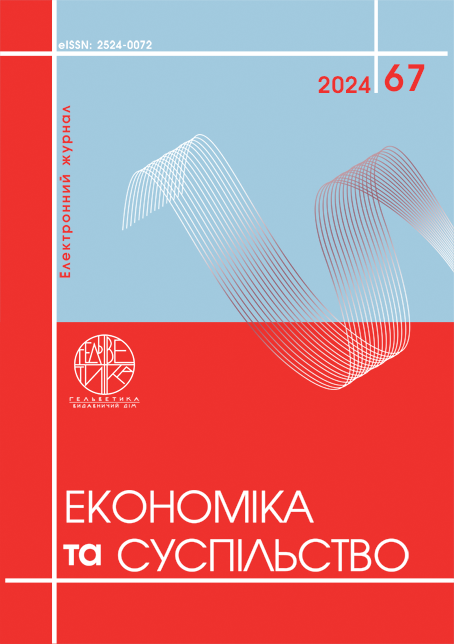LOYALTY PROGRAM: ESSENCE AND STAGES OF DEVELOPMENT
Abstract
In a highly competitive marketplace, businesses seek to strengthen customer relationships and increase customer loyalty, as retaining existing customers is often more cost-effective than attracting new ones. The attractiveness of loyalty programs lies in their ability to create a sense of benefit, exclusivity and involvement among customers. However, although the spread of loyalty programs is obvious, their effectiveness and mechanism of operation remain the subject of further research. The purpose of the article is to clarify the essence of loyalty programs, to systematize the advantages and disadvantages of loyalty programs, taking into account their types and stages of implementation. Loyalty programs are generally understood as marketing strategies designed to encourage and reward customers for repeat purchases, attracting or promoting a particular brand or business by providing various rewards, discounts, bonuses or privileges for regular purchases or use of services. It is noted that the programs are aimed at developing long-term relationships between consumers and businesses by offering customers various benefits, rewards and exclusive privileges in exchange for their loyalty and are intended to encourage consumers to purchase the company's products and actively communicate with them. Overall, loyalty programs are powerful tools for businesses to attract and retain customers in today's competitive market. Loyalty programs cover a variety of schemes, such as points-based systems, tiered membership, exclusive bonuses, and others, and are spreading across industries, covering more and more segments. The author describes such functions of a loyalty program as customer retention, increasing customer engagement, data collection, creating a competitive advantage, word-of-mouth marketing, increasing profits and strengthening customer loyalty. The advantages and disadvantages of the most common types of loyalty programs are highlighted. The author's own approach to the step-by-step process of developing and implementing a loyalty program is proposed and the essence of each stage is detailed (setting goals, identifying and analyzing the target segment, choosing the type of loyalty program, choosing rewards, developing a loyalty program mechanism, monitoring and adjusting).
References
Гросул В. А., Калєнік К. В. Лояльність споживачів як основний критерій формування конкурентних переваг підприємств ресторанного господарства. Економіка і суспільство. 2018. № 15. С. 272–277.
Іваннікова М. М. Маркетингове управління лояльністю споживачів. Маркетинг і менеджмент інновацій. 2014. № 3. С. 62–72.
Іванова Л. О., Музика О. М. Лояльність споживачів та формування їх видів на споживчому ринку. Науковий вісник НЛТУ України. 2013. № 23.7. С. 164–172.
Кляченко І. О., Зозульов О. В. Програми лояльності споживачів до бренду. Актуальні проблеми економіки та управління : збірник наукових праць молодих вчених. 2012. № 6. URL: http://surl.li/fthlxo
Нехаєнко К. Програма лояльності: сучасний зміст, типологія та методи реалізації на ринку B2C. Траєкторія науки. 2015. № 4. С. 277–292.
Панаско О. А., Микитенко Н. В. Програми лояльності покупців на підприємстві торгівлі: теоретичний та практичний ракурси. Молодий вчений. 2022. № 1 (101). С. 233–241.
Belli A. et al. 40 years of loyalty programs: how effective are they? Generalizations from a meta-analysis. Journal of the Academy of Marketing Science. 2022. Vol. 50.1, рр. 147–173.
Hrosul V. A., Kalienik K. V. (2018) Loialnist spozhyvachiv yak osnovnyi kryterii formuvannia konkurentnykh perevah pidpryiemstv restorannoho hospodarstva [Consumer loyalty as the main criterion for the formation of competitive advantages of restaurant business enterprises]. Ekonomika i suspilstvo – Economy and society, vol. 15, pp. 272–277.
Ivannikova M. M. (2014) Marketynhove upravlinnia loialnistiu spozhyvachiv [Marketing management of consumer loyalty]. Marketynh i menedzhment innovatsii - Marketing and management of innovations, vol. 3, pp. 62–72.
Ivanova L. O., Muzyka O. M. (2013) Loialnist spozhyvachiv ta formuvannia yikh vydiv na spozhyvchomu rynku [Loyalty of consumers and the formation of their types in the consumer market]. Naukovyi visnyk NLTU Ukrainy – Scientific Bulletin of NLTU of Ukraine, vol. 23.7, pp. 164–172.
Kliachenko I. O., Zozulov O. V. (2012) Prohramy loialnosti spozhyvachiv do brendu [Consumer loyalty programs for the brand]. Aktualni problemy ekonomiky ta upravlinnia – Current issues of economics and management, vol. 6. Available at: http://surl.li/fthlxo
Nekhaienko K. (2015) Prohrama loialnosti: suchasnyi zmist, typolohiia ta metody realizatsii na rynku B2C [Loyalty program: modern content, typology and implementation methods in the B2C market]. Traiektoriia nauky – The trajectory of science, vol. 4, pp. 277–292.
Panasko O. A., Mykytenko N. V. (2022) Prohramy loialnosti pokuptsiv na pidpryiemstvi torhivli: teoretychnyi ta praktychnyi rakursy [Loyalty programs for buyers at a trade enterprise: theoretical and practical perspectives]. Molodyi vchenyi – Young scientist, vol. 1 (101), pp. 233–241.
Belli, A. et al. (2022). 40 years of loyalty programs: how effective are they? Generalizations from a meta-analysis. Journal of the Academy of Marketing Science, vol. 50(1), pp. 147–173.

This work is licensed under a Creative Commons Attribution 4.0 International License.


